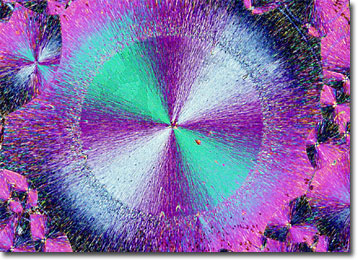Polarized Light Microscopy Digital Image Gallery
Tacrine
Tacrine is a planar three-ring acridine that was first synthesized by Australian Dr. Adrian Albert in the 1940s during his attempts to develop a new intravenous antiseptic that could be used to aid injured troops fighting in World War II. Though, the drug was never utilized for this purpose and Adrian’s efforts were brought to a close when the British discovered penicillin, decades later tacrine would gain a significant amount of attention in the medical field.

View a second image of Tacrine
In 1993, tacrine became the first pharmaceutical approved by the United States Food and Drug Administration to treat Alzheimer’s disease, the most common form of dementia in the world. Often better known by the trade name Cognex, the drug cannot cure or prevent the degenerative brain disorder, but can improve the cognitive ability of some of its sufferers, especially if they are not yet in an advanced state of the disease. Tacrine achieves its effect in the body by slowing the breakdown of the chemical messenger acetylcholine, which is heavily associated with learning and memory processes. Thus, acetylcholine is able to accumulate to greater levels within the brain and remains there longer, lessening forgetfulness and other symptoms in some patients.
Despite its possible benefits, there has been a significant amount of controversy surrounding tacrine treatment for Alzheimer’s disease and there is by no means a consensus regarding its efficacy. Moreover, the drug may cause potentially serious side effects, though they are not common. Of most concern is the fact that tacrine is sometimes associated with liver problems, though any damage caused by the drug is generally believed to be reversible. More widely prevalent, but less dangerous, are instances of headache, vomiting, shortness of breath, muscle soreness, heartburn, and loss of appetite.
